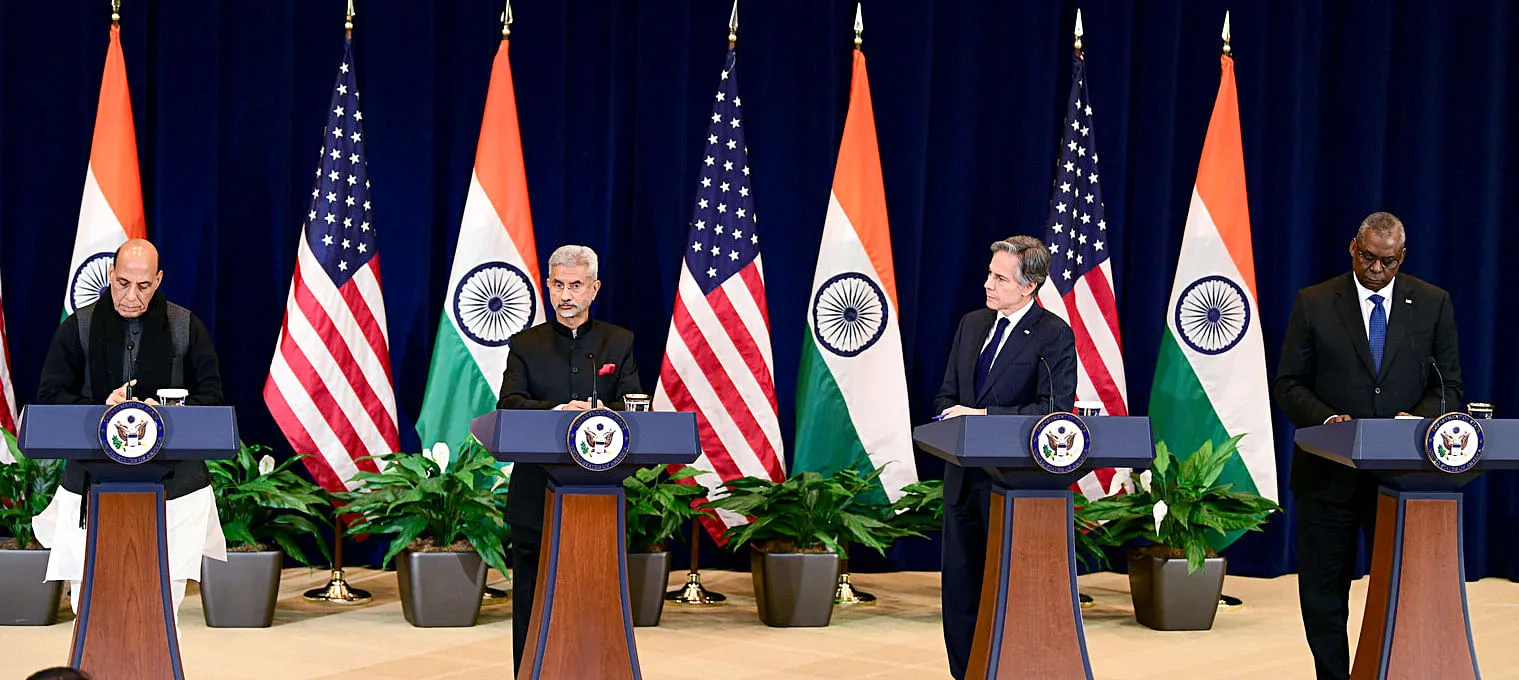Defence Minister Rajnath Singh and External Affairs Minister S Jaishankar met their US counterparts Defence Secretary Lloyd Austin and Secretary of State Anthony Blinken in Washington on April 11 for the fourth round of the 2+2 dialogue.
Their meeting was preceded by a virtual conversation between President Joe Biden and Prime Minister Narendra Modi on the same day.
The 2+2 format itself and the virtual discussion of the top leaders testify the great distance that the India-US relationship has travelled in the past four decades.
Jaishankar, who has had experience of assisting in the handling of these ties for almost four decades pointed this out while responding to a question at the joint press briefing after the 2+2 meeting. He said “We are standing for a 2+2 with a substantial defence collaboration which has happened in the last decade which we have been discussing on how to take forward.
And this wasn’t an option which was there for 40 years before that. So the world is changing”. Forty years ago the Cold War was still on. No one in the early part of the 1980s decade could have predicted that in ten years it would be over, the Soviet Union would collapse, the Warsaw Pact dissolved or that China would make the astonishing and comprehensive progress that it has in these forty years.
The Cold War had impacted negatively on India-US ties because of the choices and compulsions of both countries which were democracies then as they are now. That itself shows that for all the stale mantras that are invoked by democracies, political systems of countries only marginally impact their foreign relations.
With the Cold War over and with India changing its socio-economic path beginning from the early 1990s pathways for the intensification of India-US relations opened up and gradually but with increasing pace both countries have gone ahead on this road.
But old doubts and shadows remain which arise from the divergences which are rooted in their vastly different objective situations. Some of these have recently surfaced starkly because of Russia’s invasion of Ukraine. Others from issues such as US positions on human rights in India.
What is clear though that both countries want to restrict the impact of the divergences while strongly focussing on their cooperation including in the defence and security sectors. US wants India to adopt both in substance and perception a policy that is akin to its own on the Russian invasion of Ukraine.
Blinken acknowledged publicly that India had moved from its earlier position on this issue. India has modified its stand as shown on its emphasis on diplomacy to end the conflict as well on the need to uphold the sovereignty and territorial integrity of states. It has also condemned the Bucha massacre and civilian deaths.
What India has not done and will not do in the future too is condemn the Russian invasion of Ukraine even though it was unjustifiable from any perspective. This is the basic cause of the great gap in the Indian and US positions and the 2+2 joint statement reveals the great gap; it does not mention the Russian invasion at all, instead it notes the ‘worsening humanitarian crisis’.
There seems to a grudging acceptance in Washington at India’s need of Russia for its defence equipment and oil supplies but it is still putting pressure. The White House spokesperson’s reference to US Deputy NSA’s Daleep Singh’s recent visit to Delhi during which he spoke of ‘consequences’ if India tried to circumvent US sanctions against Russia.
Singh had also boorishly reminded India that Russia won’t come to India’s assistance if China breached the Line of Actual Control (LAC). India has shrugged off US pressure till now and no doubt will continue to do so.
In his prepared statement at the joint press conference Blinken referred to US concerns about human rights in India.
He said “We also share a commitment to democratic values, such as protecting human rights. We regularly engage with our Indian partners on these shared values, and to that end we’re monitoring some recent concerning developments in India, including a rise in human rights abuses but some government, police and prison officials”.
The fact that these were not off-the-cuff remarks and were made by Blinken when he was sharing the stage with Rajnath Singh and Jaishankar make them all the more noteworthy.
The Biden administration is under pressure from the extreme left of the Democratic party to keep raising human rights issues with India. Blinken was partly assuaging this section through his remarks but they cannot be solely attributed to this for there has been concern in the middle of the road sections of US liberal opinion on human rights in India.
Jaishankar told an Indian newspaper that while the human rights issue had not been discussed in this meeting it had been in past interactions. He also implied that India was aware why all this was done and that India too had concerns about issues relating to the Indian minorities in the US.
In sum, Jaishankar indicated that India would not be on the defensive on the subject of human rights in India.
Of course, India should not be diffident about its democratic system which is strongly rooted in the country. That in itself should lead to a policy of engagement with global liberal opinion.
It also goes without saying that all countries need to address aberrations, whenever they occur, to their constitutional values. And, the strengthening of institutions in a democratic polity should be a continuous exercise.
Disclaimer: The views and opinions expressed in this article are the personal opinions of the author.
The facts, analysis, assumptions and perspective appearing in the article do not reflect the views of GK.







